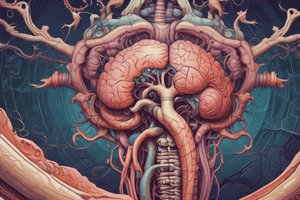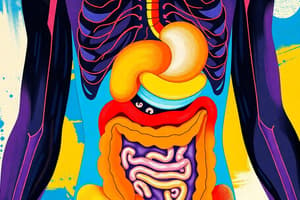Podcast
Questions and Answers
What does homeostasis primarily ensure in the body?
What does homeostasis primarily ensure in the body?
- Enhancement of sensory perception
- Increase in body temperature
- Maximization of energy production
- State of balance for cell survival (correct)
Which part of the brain is responsible for initiating automatic functions such as heart rate and breathing?
Which part of the brain is responsible for initiating automatic functions such as heart rate and breathing?
- Brain Stem (correct)
- Cerebellum
- Spinal Cord
- Cerebrum
Which structure functions as the main information highway for the nervous system?
Which structure functions as the main information highway for the nervous system?
- Neurons
- Brain Stem
- Spinal Cord (correct)
- Cerebellum
How does the nervous system respond to stimuli?
How does the nervous system respond to stimuli?
What role does the cerebellum play in the nervous system?
What role does the cerebellum play in the nervous system?
What is primarily controlled by the endocrine system?
What is primarily controlled by the endocrine system?
Which type of muscle is responsible for voluntary movement?
Which type of muscle is responsible for voluntary movement?
How do hormones reach their target cells in the body?
How do hormones reach their target cells in the body?
Which of the following is NOT a function of the endocrine system?
Which of the following is NOT a function of the endocrine system?
What distinguishes cardiac muscle from smooth muscle?
What distinguishes cardiac muscle from smooth muscle?
What is the primary function of the esophagus in the digestive system?
What is the primary function of the esophagus in the digestive system?
Which process occurs in the stomach during digestion?
Which process occurs in the stomach during digestion?
What is the role of the liver in the digestive process?
What is the role of the liver in the digestive process?
What is the primary function of the large intestine?
What is the primary function of the large intestine?
What does the rectum do in the digestive system?
What does the rectum do in the digestive system?
What role does the gallbladder play in digestion?
What role does the gallbladder play in digestion?
Which function is NOT associated with the integumentary system?
Which function is NOT associated with the integumentary system?
Which of the following correctly describes a ligament?
Which of the following correctly describes a ligament?
What is the primary function of cartilage in the skeletal system?
What is the primary function of cartilage in the skeletal system?
What is a function of the pancreas in the digestive system?
What is a function of the pancreas in the digestive system?
Which organ primarily excretes carbon dioxide from the blood?
Which organ primarily excretes carbon dioxide from the blood?
What is the main role of the kidneys in the excretory system?
What is the main role of the kidneys in the excretory system?
Which component of the circulatory system is made of cardiac muscles?
Which component of the circulatory system is made of cardiac muscles?
Which part of the urinary system stores urine until it is expelled from the body?
Which part of the urinary system stores urine until it is expelled from the body?
What type of blood does the heart transport away from the lungs?
What type of blood does the heart transport away from the lungs?
What type of blood do arteries typically carry?
What type of blood do arteries typically carry?
Which of the following correctly describes a function of blood?
Which of the following correctly describes a function of blood?
What are the chambers of the heart called?
What are the chambers of the heart called?
What is the primary role of capillaries in the circulatory system?
What is the primary role of capillaries in the circulatory system?
Which statement accurately reflects the structure of the heart?
Which statement accurately reflects the structure of the heart?
What is the primary function of red blood cells?
What is the primary function of red blood cells?
Which type of blood cell leaves the bloodstream to assist in tissue repair?
Which type of blood cell leaves the bloodstream to assist in tissue repair?
During which step does oxygen transfer from the lungs to the circulatory system?
During which step does oxygen transfer from the lungs to the circulatory system?
What role do platelets play in the body?
What role do platelets play in the body?
What is the waste product that is removed from the body during the respiratory process?
What is the waste product that is removed from the body during the respiratory process?
What happens to the diaphragm during inhalation?
What happens to the diaphragm during inhalation?
Where does fertilization take place in the female reproductive system?
Where does fertilization take place in the female reproductive system?
What is the structure that develops after the zygote implants into the uterine lining?
What is the structure that develops after the zygote implants into the uterine lining?
What occurs during exhalation?
What occurs during exhalation?
Which hormone-related function is performed by the ovaries?
Which hormone-related function is performed by the ovaries?
What is the primary function of the alveoli in the respiratory system?
What is the primary function of the alveoli in the respiratory system?
What role does the epiglottis play during swallowing?
What role does the epiglottis play during swallowing?
Which structure is responsible for the voice production?
Which structure is responsible for the voice production?
What is the effect of the diaphragm contracting during inhalation?
What is the effect of the diaphragm contracting during inhalation?
Which of the following correctly describes the pathway of oxygen through the respiratory system?
Which of the following correctly describes the pathway of oxygen through the respiratory system?
What happens to carbon dioxide in the respiratory system?
What happens to carbon dioxide in the respiratory system?
How do the bronchi contribute to the respiratory system?
How do the bronchi contribute to the respiratory system?
What is NOT a function of the nasal cavity?
What is NOT a function of the nasal cavity?
Flashcards
Homeostasis
Homeostasis
The body's stable internal environment, necessary for cell survival.
Stimulus
Stimulus
A change in the environment that triggers a response.
Nervous System Function
Nervous System Function
Controls body functions and responses to changes.
Spinal Cord
Spinal Cord
Signup and view all the flashcards
Cerebrum
Cerebrum
Signup and view all the flashcards
Endocrine system function
Endocrine system function
Signup and view all the flashcards
Hormone definition
Hormone definition
Signup and view all the flashcards
Involuntary muscle movement
Involuntary muscle movement
Signup and view all the flashcards
Voluntary muscle movement
Voluntary muscle movement
Signup and view all the flashcards
Types of muscles
Types of muscles
Signup and view all the flashcards
Digestion
Digestion
Signup and view all the flashcards
Peristalsis
Peristalsis
Signup and view all the flashcards
Chyme
Chyme
Signup and view all the flashcards
Small Intestine's Role
Small Intestine's Role
Signup and view all the flashcards
Liver's Digestive Function
Liver's Digestive Function
Signup and view all the flashcards
Gallbladder's Role
Gallbladder's Role
Signup and view all the flashcards
Pancreas Function
Pancreas Function
Signup and view all the flashcards
Skin's Protection
Skin's Protection
Signup and view all the flashcards
Skeletal System Purpose
Skeletal System Purpose
Signup and view all the flashcards
Connective Tissue: Tendon
Connective Tissue: Tendon
Signup and view all the flashcards
Heart Function
Heart Function
Signup and view all the flashcards
Veins vs. Arteries
Veins vs. Arteries
Signup and view all the flashcards
Capillary Function
Capillary Function
Signup and view all the flashcards
Blood Components
Blood Components
Signup and view all the flashcards
What does blood do?
What does blood do?
Signup and view all the flashcards
Red blood cells
Red blood cells
Signup and view all the flashcards
What does the excretory system remove?
What does the excretory system remove?
Signup and view all the flashcards
White blood cells
White blood cells
Signup and view all the flashcards
What are the organs of the excretory system?
What are the organs of the excretory system?
Signup and view all the flashcards
What is the urinary system?
What is the urinary system?
Signup and view all the flashcards
Platelets
Platelets
Signup and view all the flashcards
Respiratory System Function
Respiratory System Function
Signup and view all the flashcards
What does the circulatory system transport?
What does the circulatory system transport?
Signup and view all the flashcards
How does oxygen reach the cells?
How does oxygen reach the cells?
Signup and view all the flashcards
What are the main parts of the circulatory system?
What are the main parts of the circulatory system?
Signup and view all the flashcards
What causes air to flow into the lungs?
What causes air to flow into the lungs?
Signup and view all the flashcards
How does exhaling work?
How does exhaling work?
Signup and view all the flashcards
What are ovaries responsible for?
What are ovaries responsible for?
Signup and view all the flashcards
What are testes responsible for?
What are testes responsible for?
Signup and view all the flashcards
What happens during fertilization?
What happens during fertilization?
Signup and view all the flashcards
Nasal Cavity
Nasal Cavity
Signup and view all the flashcards
Pharynx
Pharynx
Signup and view all the flashcards
Trachea
Trachea
Signup and view all the flashcards
Larynx
Larynx
Signup and view all the flashcards
Epiglottis
Epiglottis
Signup and view all the flashcards
Bronchi
Bronchi
Signup and view all the flashcards
Alveoli
Alveoli
Signup and view all the flashcards
Diaphragm's role in Breathing
Diaphragm's role in Breathing
Signup and view all the flashcards




